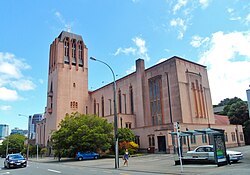| Wellington Cathedral of St Paul | |
|---|---|
| |
 St Paul's Cathedral | |
 | |
| 41°16′35″S174°46′39″E / 41.2763°S 174.7774°E | |
| Location | Hill Street, Thorndon, Wellington |
| Country | New Zealand |
| Denomination | Anglican |
| Website | wellingtoncathedral |
| History | |
| Status | Cathedral (since 1964) |
| Founded | 13 January 1954 |
| Dedication | Paul the Apostle |
| Dedicated | 17 May 1964 |
| Consecrated | 15 October 2001 |
| Architecture | |
| Functional status | Active |
| Architect(s) | Cecil Wood |
| Architectural type | Church |
| Style | |
| Years built | 1954 –2002 |
| Specifications | |
| Length | 88 metres (289 ft) |
| Height | 18 metres (59 ft) |
| Materials | Reinforced concrete |
| Bells | 14 |
| Administration | |
| Province | New Zealand |
| Diocese | Wellington |
| Parish | Wellington City |
| Clergy | |
| Archbishop | Justin Duckworth |
| Dean | Katie Lawrence |
| Precentor | Sue Paton |
| Deacon(s) | Chris Frazer |
| Laity | |
| Director of music | Michael Stewart |
The Wellington Cathedral of St Paul, also called St Paul's Cathedral or Wellington Cathedral, is an Anglican cathedral church located on Hill Street, at its junction with Molesworth Street, in Thorndon, in the city of Wellington, New Zealand. It is situated close to the parliament precinct.
Contents
- Services
- History
- Background
- Construction
- Chapels
- Features
- Artwork and memorials
- Font
- Organ
- Bells
- Deans of St Paul
- Gallery
- See also
- References
- External links
The cathedral is the mother church of the Diocese of Wellington and the seat of the Bishop of Wellington, within the Anglican Church in Aotearoa, New Zealand and Polynesia.
The building was designed in the 1930s by New Zealand architect Cecil Wood. Construction began in 1954, and was completed in 1998. It was constructed in reinforced concrete due to the effects of the 1931 Napier earthquake making other choices impractical. The church was initially envisioned as a war memorial cathedral, and it was designed on a monumental scale. The Archbishop of New Zealand, Reginald Herbert Owen, declared in 1958: "Every nation needs in its capital city a great church to express its belief in the things of the spirit". [1] The building began to be used as an Anglican cathedral in 1964 (replacing Old St Paul's), [1] [2] and was consecrated in 2001. [3]











